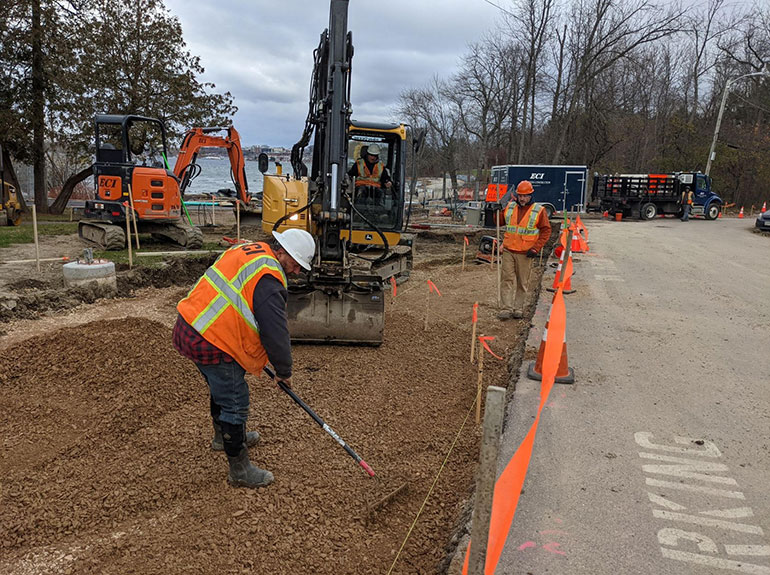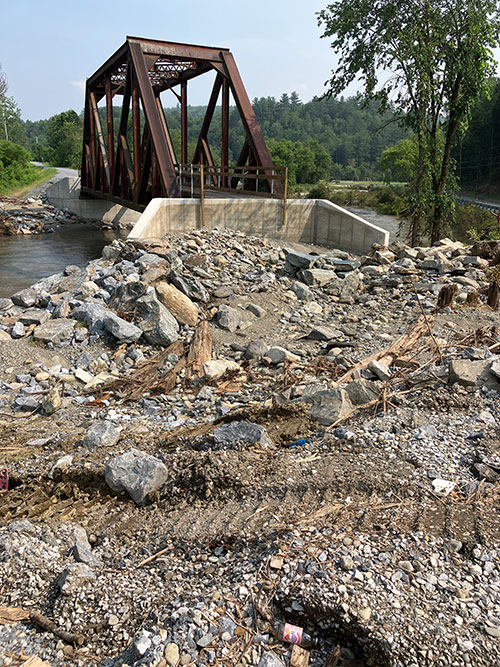
Vermont Railway quickly fixed this section of track in July that was hanging ten in East Wallingford. Vermont Railway photo.
by Joy Choquette, Vermont Business Magazine A verse in a popular children’s song describes transportation in simple terms: No matter how we travel, by train, plane, car or boat, by bus, bike or whatever, we’ll see the whole world!
What’s going on in Vermont transportation now? Are there new incentives business owners can offer employees? How did the summer flooding affect transportation around the state? And has a full recovery been made?
Where Things Stand in 2023
Transportation may seem like an afterthought to most Vermonters. If you want to get somewhere, you get into your vehicle and go. It can be more complicated, however. With nearly two-thirds of Vermonters living in rural areas, getting from Point A to Point B can be tricky.
Add in significant weather challenges, particularly in the winter months, economic issues, a desire for greener transportation options and reaching one’s destination can become complicated.
Amtrak is a solution for some. The railway, which has been part of Vermont’s landscape for decades, serves residents and visitors from as far north as St. Albans and as far south as Brattleboro. It also crosses state borders, offering services to popular northeastern destinations like Boston, New York City and Washington D.C.
While ridership figures for 2023 have yet to be released, data shows that Amtrak enjoyed a strong 2022, according to Jen Flanagan, lead public relations specialist at the passenger railroad company.
The largest number of Amtrak travelers was in and out of the Essex Junction station. It had 17,412 riders last year alone. Following on its heels was Brattleboro, with $13,850 riders. The station with the lowest number of riders — 633 — was Ferrisburgh-Vergennes.
“We look forward to welcoming new and returning customers on board,“ said Flanagan.
For the autumn season, she added, “we suggest a window seat for customers who have an interest in enjoying the view of the foliage. The large windows, spacious seats with ample leg room and no middle seat make for the perfect setting for a fall foliage journey.“

Photo: Amtrak station in St. Albans. Photo: Joy Choquette
What’s New in Transportation?
It’s been a full year for the Vermont Agency of Transportation, and its about to get a little fuller. In an Aug. 15 news release, Gov. Scott said the agency would also be responsible for modifying existing incentives for victims of the summer flood.
The Replace Your Ride program, for instance, increased program guidelines to include flood-damaged vehicles, whether they are drivable or not. Likewise, the Incentive Program for New Plug-in Electric Vehicles offers an additional $1,000 incentive (up to $6,000 total) for Vermonters replacing a flood-damaged vehicle.
The MileageSmart Program, a state program that offers income-eligible residents a 25% subsidy on the initial purchase price of qualifying high-efficiency, pre-owned vehicles, up to $5,000, will extend the incentive to those replacing a vehicle damaged by summer flooding.
Hilary DelRoss, sustainability projects coordinator at the transportation agency. said all flood-incentive programs had to adhere to state guidelines for existing programs.
“The package of flood incentives, therefore, comprised not wholly new programs created by the administration but creative adaptations of current vehicle incentive programs,“ she noted.
How Much Did the Great Flood Affect Transportation?
Richard Wobby Jr., executive vice president of the Associated General Contractors of Vermont, said infrastructure repairs around the state are “coming along very well.
“About 50% to 60% of the state’s repairs to keep our infrastructure in place have been completed,“ Wobby said. “Another 40% have to be included in the contracting process, versus just putting it back together.“

Photo: Repair work post-flood. Photo credit: Associated General Contractors of Vermont.
Workers are simultaneously tackling projects for every major sector of the state, including the municipal, residential and business communities, Wobby added.
“Municipal repairs are moving slower,“ he said. “Part of the reason is the amount of funding available and whether the money has been budgeted to do these repairs.“
As an example, Wobby said a town like Northfield would have three options for financing necessary flood repairs: Federal Emergency Management Agency grants, state funds or raising taxes.
“That’s slowing down the rate of recovery,“ he said.
Overall though, Wobby said the state, its contractors and municipalities have “been working hand in hand really well.“
This is in part due to experience. Post-(Tropical Storm) Irene we built things back better,“ Wobby noted. “Areas have been able to rebuild faster.“
Meanwhile, Selden Houghton, president of the Vermont Rail System, which provides freight services to communities in Vermont, New Hampshire and New York as well as seasonal passenger services, said repairs to tracks and embankments that were damaged by summer flooding continues apace.
“The railway has been up and running since the end of July,“ Houghton said
The line between Rutland and Bellows Falls was worst hit, but Vermont Rail System had that line fully operational by the end of July. Now, Houghton said, “we’re finishing up on repairs that don’t necessarily rely on trains running.“
This includes longer-term repairs like abutment and bridge work, some of which are done in conjunction with the Agency of Transportation.
Houghton said that some areas of the state suffered flood damage this summer on a par with the damage caused by Tropical Storm Irene.
“The damage on the Green Mountain Railway was comparable to Irene,“ said Houghton, though more bridges were affected during Irene. This year’s flooding caused more damage to lines south of Rutland, down to North Bennington, Houghton explained.
“We’re working very closely with AOT to get the final repairs done,“ he said.
The railway service is coordinating mitigation efforts with the transporation agency for future storms and other issues that might affect rail travel, Houghton added.
Ann Gammell, AOT’s chief engineer and highway division director, said July’s weather-related emergency response highlighted the benefits of the agency’s coordinated efforts with its federal partners. As a consequence, she addded, “we are able to improve our infrastructure as we rebuild to be more resilient and not just replace in-kind.“
The Lamoille Valley Rail Trail was hit hard by flooding too, according to Amy Tatko, director of communications and public outreach at AOT. While much of the trail has been repaired and reopened, the 21.1 miles between Wolcott and Walden remain fully closed until further notice.

Photo: Lamoille Valley Rail Trail’s Wolcott bridge. Photo courtesy .Vermont Rail Systems
Floods caused bridge and culvert washouts and severe slope failures in some parts of the state, Tatko said.
“Among the closed sites are several that require civil engineering planning and will be long-term projects with repairs that are not likely to be completed until sometime in 2024,“ Tatko said. “The specific timelines will be dependent on materials, contractor availability and permitting required to complete the projects.“
At an Oct. 18 new conference, Gov. Scott said the Lamoille Valley Rail Trail section between Wolcott and Hardwick was scheduled to open Oct. 21. This would mean that 79.5 miles of the 94-mile trail would be operational.
At that same event, Transportation Secretary Joe Flynn emphasized the importance of “resiliency,“ a standard that calls for designing infrastructure not only to withstand current risks, hazards and threats but to plan for the design life of the infrastructure and future hazards that may arise.
Flynn added that when infrastructure was rebuilt to that design standard after Tropical Storm Irene in 2011, the roads, culverts and bridges were much better able to hold up to the impact from the July rains.
“Every storm is different,“ he said, adding that the state should begin preparing for future such events.
Transportation: 2023 in Review
AOT’s Gammell said that funding challenges have been more acute this summer than in past disasters.
“The Infrastructure Investment and Jobs Act sent more money to Vermont, but the inflationary increases (elevated) project costs,“ she said.
Likewise, too much work and a lack of competition have eaten into the increased programs.
“So, we ended up not being able to put out additional projects,“ Gammell explained.
Michael Booth, district transportation administrator for the District Maintenance and Fleet Division at AOT, said that 2023’s weather-related challenges weren’t unique.
“We had many of the same types of problems that occurred during the Irene event,“ he stated. However, “the flooding this summer has slowed new initiatives.“
Booth added that a new challenge facing the state is establishing stations to charge electric vehicles.
“We are working various ways to expand the charging network throughout the state,“ he said. “This will provide EV users more charging opportunities.“
Bike, Walk and Roll
Rail trails offer another form of transportation throughout the state. Tatko pointed to an impact study that found the LVRT “has the potential to generate up to $4.7 million in total annual sales activity in Caledonia County and beyond in northern Vermont.“
“Vermont’s rail trails are incredibly powerful tools for economic development and are reinvigorating many communities throughout the state,“ said Jonathon Weber, senior program manager at Local Motion, a nonprofit organization working to make it safe, accessible and fun for Vermonters to “bike, walk and roll.“
“Unfortunately, we are lacking the safe and comfortable on-road infrastructure that’s needed to maximize this benefit,“ Weber said.
Weber added that support from the Legislature and the Agency of Transportation are key to finding a solution to this issue.
“We need significantly increased funding for bike and pedestrian infrastructure projects and remedies to regulations and policies that create barriers to constructing better walking and biking infrastructure,“ he said.
Additional nonvehicle-dependent options would be welcomed, Weber said.
“The cost of transportation has increased with the price of fuel,“ added Gammell. “For a rural state, everyone is having to reevaluate their options and lifestyle. It is a major change and uncomfortable for some.“
Transportation and Businesses
The Missisquoi Valley Rail Trail has created a trail-friendly program built on strong relationships between trail users and area businesses, said Weber. A trail-friendly business map helps those using the trail to find spots to stop for a meal, a drink or a retail visit interactively via their phones, he said.

Photo: Missisquoi Valley Rail Trail. Photo credit: Joy Choquette.
“A similar program is being developed for the LVRT, but it is not active yet,“ Weber said.
Local Motion has its own interactive map for businesses along the Island Line Trail, he added.
“Burlington’s downtown and waterfront is a magnet for travelers,“ he said. “Local Motion developed an interactive map to help our bike rental customers ’Know Where to Go’ to discover hotels, restaurants, breweries, museums, shops, public parking, restrooms, parks, beaches and more.“
The organization’s map displays participating advertiser locations as well as important visitor amenities.
“As we grow our advertiser base, more and more visitors are finding this a valuable tool,“ Weber said.
The AOT’s DelRoss noted that the organization is preparing to launch an incentive program to encourage fleet electrification to reduce the climate impacts from commercial, municipal and nonprofit fleets.
“The program will help business owners to fund the replacement of their internal combustion engine vehicles with cleaner electric options for their fleets,“ DelRoss said.
Wobby stated he is worried that AOT work for 2024 has yet to be released.
“If it’s held off until spring, then you’re going to see a downturn in the number of jobs,“ he said.
The state’s cycle runs from July 1 to June 30. In most years, there are 100 jobs completed during that 12-month period.
“Usually by this time of the year, you’ve got 60% out on the ground and being bid,“ said Wobby. That figure currently stands at around 30%, likely due to the flooding
When jobs are “let,“ or released, by the state, completion is expected within the July to June time period. If a job is let mid-year, Wobby noted, it is still expected to be completed within six months. That puts a lot of pressure on contractors and their teams.
“How can I allocate my workforce for what’s out there?“ Wobby said he is asked by many contractors. “When there’s a roadblock, contractors start to get nervous. Is AOT going to release these or spend the money in other areas?“
For contractors, a mix of hope and frustration has taken hold. Wobby said.
“On one hand, they’re very optimistic about the future,“ he said. “On the other hand, they’re worried about the increased cost of delivery times and materials. That’s playing out fairly big in the whole outlook piece.“
Joy Choquette writes from the Franklin County area.


